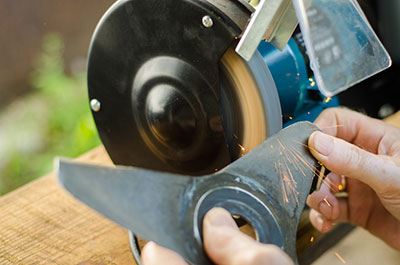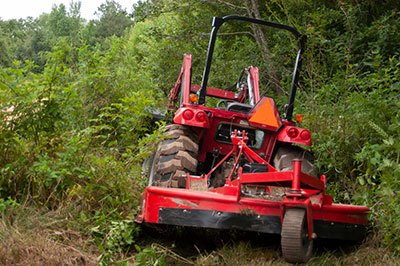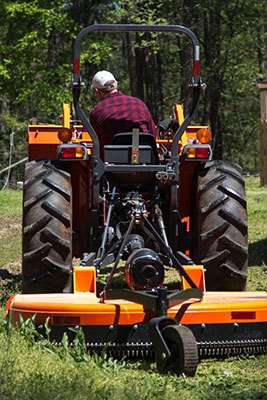Are you a busy homeowner, rancher, or farmer looking for ways to save time and money?
If so, then learning how to sharpen your bush hog blades may be the answer. Not only will this task save you valuable hours in-store visits and maintenance bills, but it also increases their lifespan – which can mean saving hundreds of dollars over time!
In this blog post, we’ll show you the basics of how to safely sharpen your bush hog blades at home with simple tools and techniques.
With our simple steps and helpful tips, in no time at all, you’ll be well-equipped to keep your precious, sharp blades in the best shape possible!
So let’s get started and find out why regular upkeep pays off big!
Take away key notes:
- Be sure to use safety gloves when handling the brush hog blades.
- Use a file or whetstone to sharpen the brush hog blades.
- Once you sharpen brush hog blades, put them back to their original positions and torque them to their specified settings for optimum performance and safety.
- Sharp hog blades require less power to work on heavy duty tasks and offer better control.
Table of Contents
Preparation: What you need before sharpening brush hog blades?
Preparing before sharpening your brush hog blades is important to ensure a safe and successful sharpening process.
Here are some things you should have before getting started:

Protective gear – Sharpening blades can create debris that can be harmful if it comes in contact with your eyes or skin, so it is important to wear protective gear. Protective gear can include work gloves, safety glasses and earplugs to protect your eyes and ears from flying debris.
Sharpening tools – You’ll need a file, grinder, or any other sharpening tool that can effectively sharpen your brush hog blades. Consider getting a bush hog blade-specific sharpening tool as it will provide a more uniform edge on the bush hog blade.
Cleaning materials – Before sharpening, ensure the brush hog blades are free of dirt, rust, and debris. You will need a wire brush or sandpaper to clean the blades.
Work area – A clear, well-lit workspace is essential to ensure safe and accurate sharpening. A sturdy workbench or table with a vice to hold your blades during sharpening is also important.
Manual or online guide – Understanding the specifications and the sharpening process is crucial. You can use the bush hog owner’s manual for guidance or check online for specific instructions on how to sharpen bush hog blades.
Proper sharpening technique: Angle, pressure, and timing
Proper sharpening technique is critical to achieving a sharp edge on your brush hog blades.
There are three key factors to consider when sharpening your blades: angle, pressure, and timing.
1. Angle
The angle of your sharpening tool against the blade is a critical factor for achieving a sharp edge.
The ideal sharpening angle can vary depending on the blade type and the manufacturer’s recommendations.
Typically, brush hog blades require an angle between 25 to 45 degrees.
Make sure you use a sharpening tool that is specifically designed for sharpening brush hog blades and maintain the correct sharpening angle throughout the process.
2. Pressure
Applying the correct and even pressure when sharpening your bush hog blades is also essential.
Applying too much pressure can cause the blade’s edge to become damaged, while too little pressure can result in an uneven edge.
Aim for steady, moderate even pressure to achieve an even surface on the blade’s edge.
3. Timing
The length of time you sharpen each blade is also critical.
Sharpen for too long and you risk removing too much material from the bush hog blade surface, while not sharpening enough means your blade may not have the same level of performance.
Use a consistent and patient technique, ensuring that each pass over the bush hog blade is consistent in length and pressure to avoid over-sharpening or under-sharpening the blade.
Common sharpening methods for bush hog blade
1. File sharpening
The file sharpening method is a manual way of sharpening bush hog dull blades to restore their cutting efficiency. It involves using a mill file, which is a type of file that has one set of diagonal teeth that run in one direction.
This sharpening method is a suitable approach for sharpening dull blades that are only slightly dull or have a few small nicks that need to be evened out.
The process of file sharpening involves securing the dull blade in a vice, cleaning it thoroughly with a wire brush, and checking its angle to select the right file angle.
The file is then held at the same angle as the cutting edge of the dull blade and applied in a back-and-forth motion along the edge to remove small amounts of metal until the edge is sharpened.
Once the sharpening is complete, the blade is cleaned and reinstalled in the bush hog.
2. Angle grinder sharpening

Angle grinder method of sharpening bush hog dull blade using an angle grinder tool.
It is a more aggressive method compared to other sharpening methods and is suitable for blades that are significantly dulled and may have nicks, dents, or significant damage that require large amounts of metal to be removed.
The angle grinder is equipped with a metal grinding disc, which is applied to the blade’s edge to remove excess metal and create a new edge. During this process, a protective gear is required, including gloves, eye protection, and hearing protection.
Sharpening with an angle grinder is faster and more effective than sharpening with a file, but you need the right tools and to know how to use an angle grinder.
3. Professional sharpening
Professional sharpening involves sending your brush hogs blades to a professional sharpening service to be sharpened.
This service involves professionals using specialized equipment to restore the blades to original cutting efficiency.
Professional sharpening services often use a range of specialized tools and machine like computer-controlled grinders to ensure your blades are sharpened at the recommended angles and meet the original manufacturer’s specifications.
This method can help to deliver a consistent edge, reduce the chances of imbalances on blades, and extend the life of your bush hog blades.
4. Belt sander
The belt sander method of sharpening bush hog blades involves using an electric belt sander to sharpen the blades. It is a relatively quick and efficient way to sharpen blades that are not terribly dulled or damaged, as it requires minimal effort to achieve the desired results.
The process involves running a belt sander along the edge of the blade several times, usually in increments ranging from 10-15 seconds each time. For this method, protective gear is also necessary including gloves, eye protection, and hearing protection.
Unlike angle grinder sharpening, this method does not involve removing large amounts of metal from the blade. Instead it quickly removes some material from the cutting edge to restore its original sharpness. This process can be done at home and does not require much expertise.
Removing the blades from your bush hog
Power down the bush hog – Ensure that your bush hog is completely turned off and the engine is cooled down. To avoid accidentally starting the bush hog during the removal process, or accidentally falling on you, disconnect the spark plug wire or disconnect the battery.
Secure the bush hog – You will need to secure the bush hog on level ground. Use jack stands, cinder blocks, or ramps to lift it off the ground to access the blades safely. Make sure to block the grinding wheel of the mower deck to prevent accidental movement.
Locate the blade bolts – Look for the bolts that secure the blade to the bush hog. They are located at the center point of the blade where the blade connects to the spindle assembly.
Remove the bolts – Once you have located the bolts, loosen them with a impact wrench counterclockwise until they come out completely. It may help to hold the blade steady with your other hand or get someone to help you.
Remove the blade – Pull the blade off of the spindle assembly. You may need to gently tap the dull blade loose with a rubber mallet, taking care not to damage the blade and its edges.
Repeat the process – Repeat the process on the other side of the bush hog until both blades have been removed.
Reinstalling your blades correctly

Use the original mounting hardware if possible to ensure a secure fit. If any of the original parts have been lost, damaged or worn out, replace them with new ones that match the manufacturer’s specifications.
Make sure all bolts and nuts are tight and in good condition before starting the mower.
Take time to properly align the cutters on your bush hog according to the manufacturer’s instructions. This will help avoid uneven cutting and unnecessary wear on your blades.
Check that all bolts are securely tightened after allowing sufficient time for everything to settle in place
Grease all shafts, bearings and other moving parts to reduce friction when using the bush hog. This will further extend the life of your blades and prevent unnecessary wear on them too.
FAQs
What is the best way to sharpen bush hog blades?
The best way to sharpen bush hog blades is by using an angle grinder method.
An angle grinder is a handheld power tool that has two grinding wheels attached to it, which can be used to sharpen the cutting edges of your blades quickly and easily.
Can you sharpen a brush cutter blade?
Yes, it is possible to sharpen a brush cutter blade. The best way to do so is by using a bench grinder method or an electric belt sander.
It’s important to use protective gear, such as gloves and safety glasses, when sharpening the blade and to follow the instructions provided with the tool for optimal results.
How do you sharpen bush hog blades without removing them?
It is possible to sharpen bush hog blades without removing them from the mower.
The best way to do this is to use an electric belt sander. This method requires minimal effort and can be completed quickly and efficiently.
How often do you sharpen bush hog blades?
The frequency of sharpening bush hog blades depends on a variety of factors, such as the type of tall grass and soil conditions you are cutting through, the amount of wear and tear on the blades, and the quality of the sharp blades.
Generally speaking, it is recommended to sharpen your bush hog blades at least once or twice a year to maintain their condition and performance.
How sharp do bush hog blades need to be?
Bush hog blades need to be sufficiently sharp in order to cut through grass and soil efficiently and to prevent the dull blades tear the grass.
The best way to check the sharpness of your bush hog blades is to run your thumb over the blade edge while wearing gloves. Be careful when checking the razor-sharp edge!
How do you sharpen Land Pride rotary cutter blades?
Sharpening Land Pride rotary cutters is easy.
First, remove the blades from the mower and arrange them so you can see both sides. Then, file each blade until it’s sharp yet safe. Next, reinstall the blades and tighten them to the mower’s specifications.
Conclusion
Like all the other blades, sharpening bush hog blades is a relatively easy task that requires the use of safety gloves and a file or whetstone.
Sharpening blades will require less power from the hog to perfom a task, and make every cutting job more easier!
Additionally, bolting them back to their original positions and torquing them to their specified settings will ensure optimum performance and safety when using bush hog blades.
